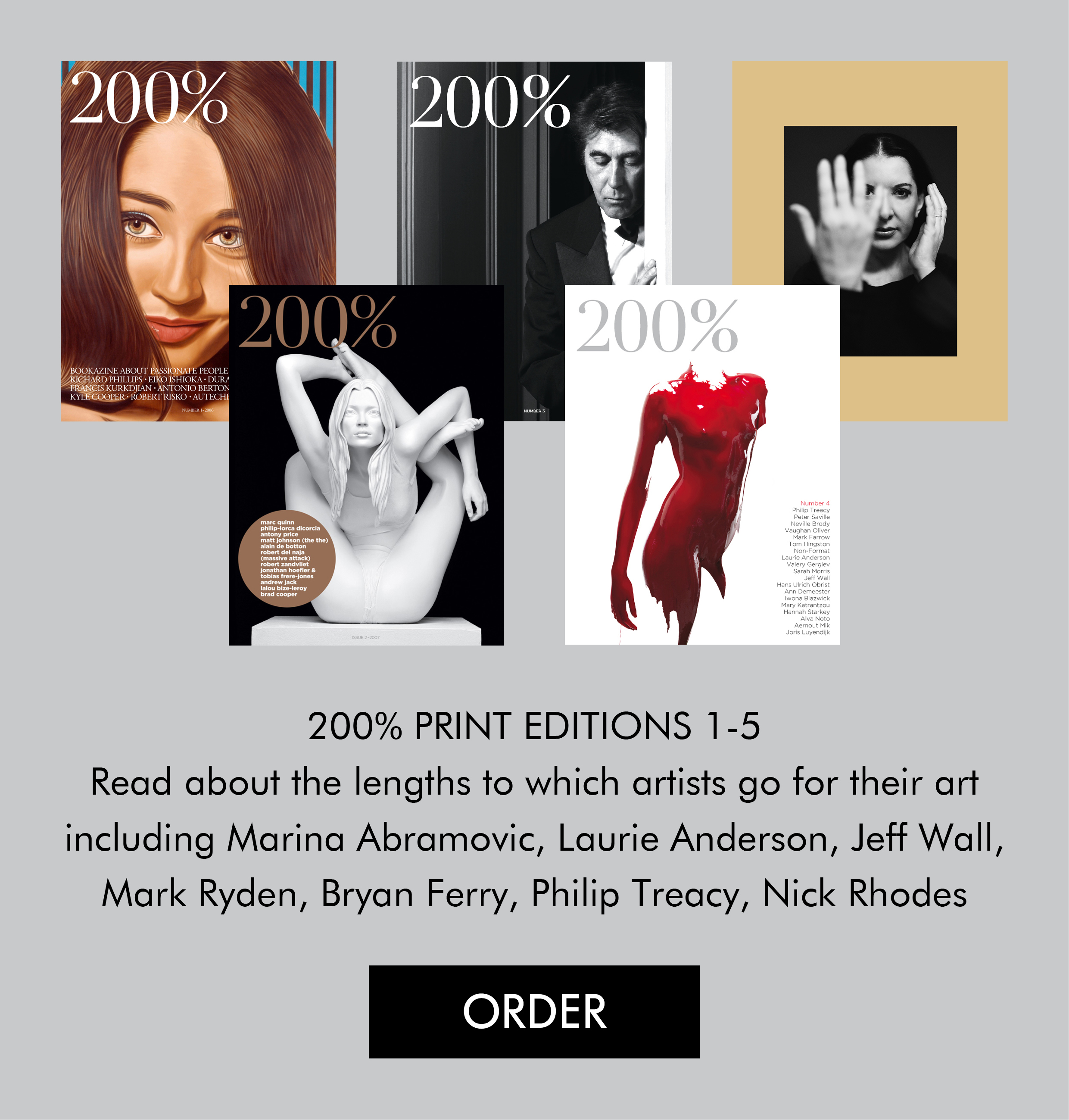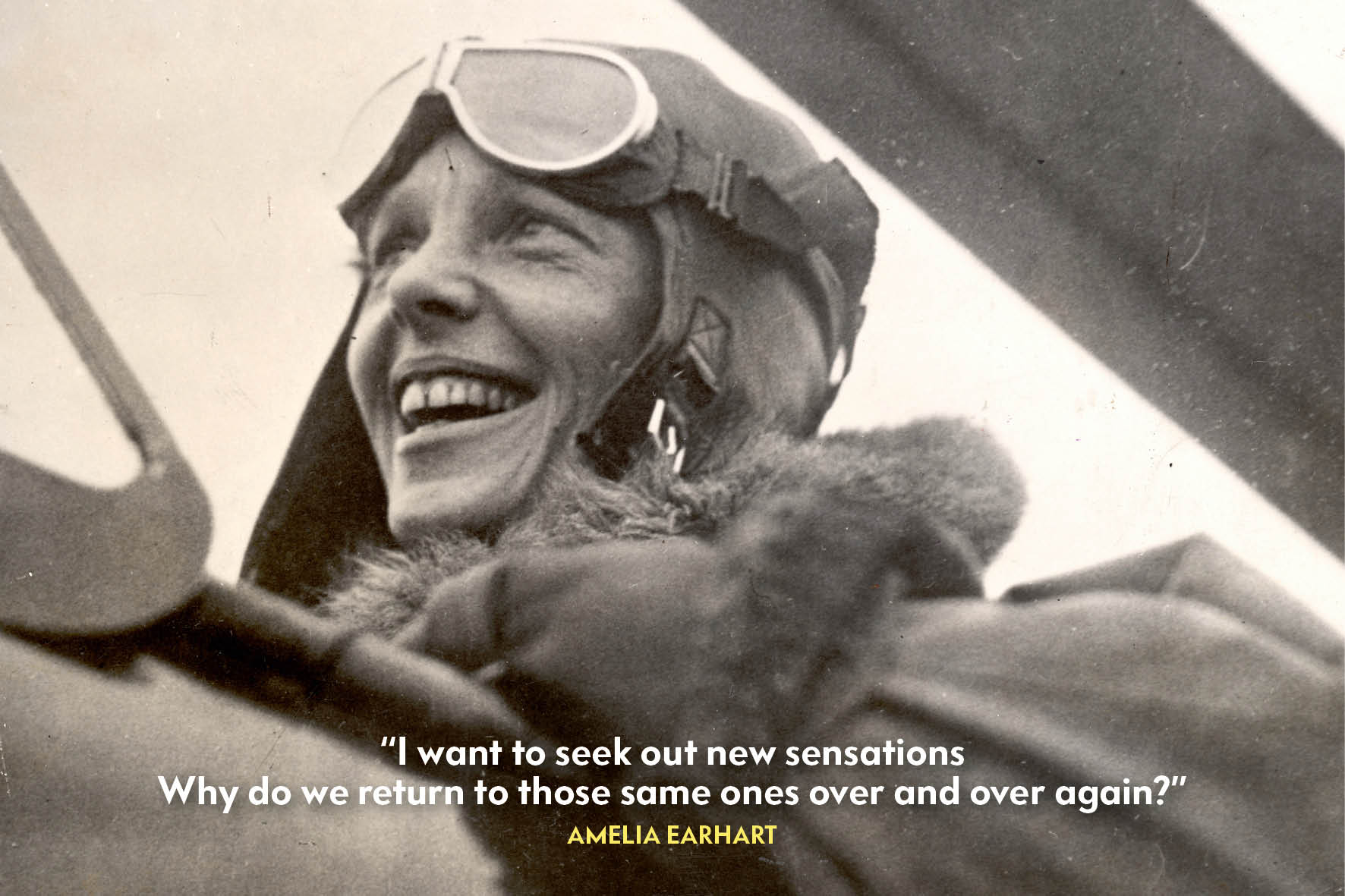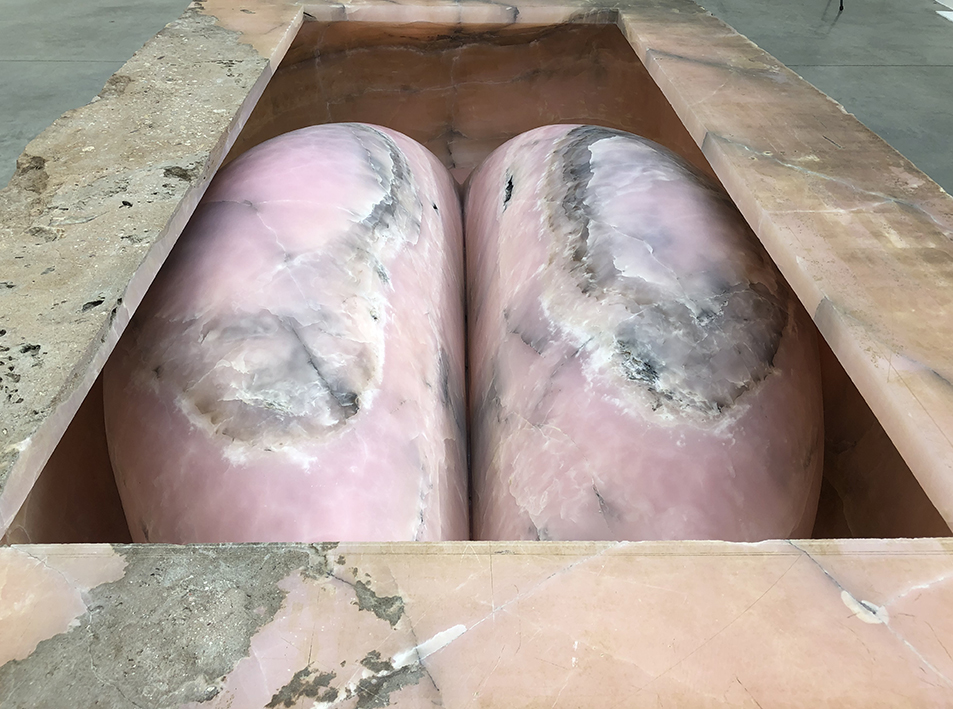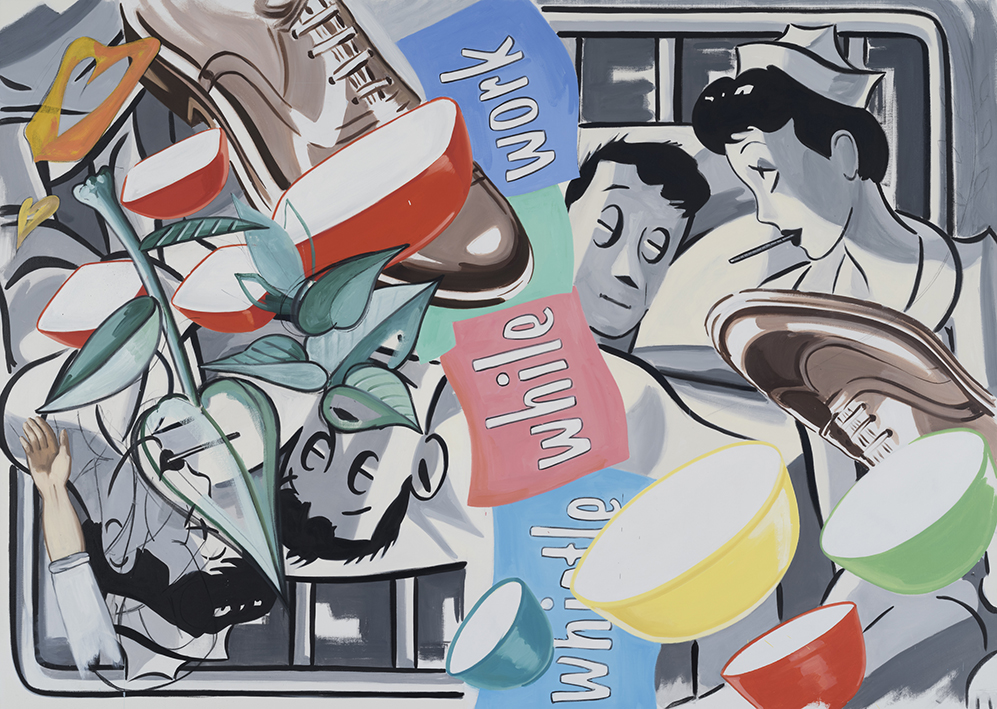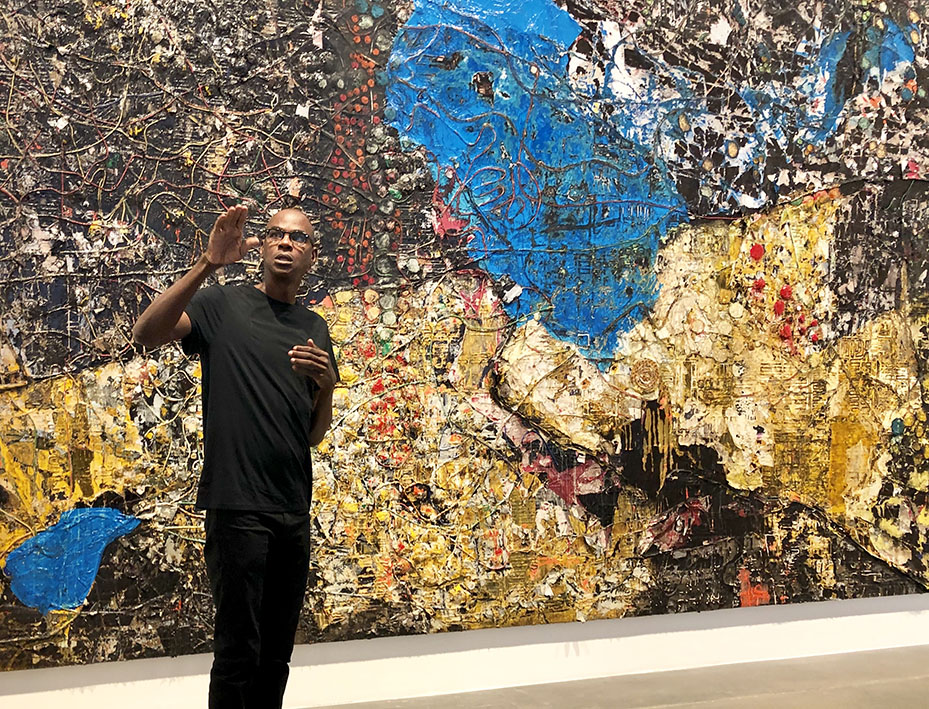 One of the highlights of the Central Saint Martins MA collection presented at London Fashion Week (February, 2011) was the work of the young designer Shaun Samson. The work of the graphic artist M.C. Escher was one of the inspirations of Samson’s menswear collection for which he fused plaid wool, Aran knitwear and denim into a single fabric, using the ‘felting’ treatment. Samson presented a visually arresting collection that looked sophisticated, artistic and minimalistic.
In our interview with Samson talked about the process of the ‘felting’ treatment, Louise Wilson’s contribution to his MA collection, and what he considers to be the difference in struggles between ‘young’ and established designers.
200%: How long did you work on your MA collection?
Shaun Samson: I started research during the Summer holiday before my final year, and worked on it up to the Press Show in February 2011. Thus, I’d say it was around six months, similar to working on a normal Fall collection. During that time, though, there was a lot of “shit work” that lead to absolutely nothing. Toward the end of that six months, however, everything was scratched and I started over again. I used the same reference points, but revamped all the shapes. I think after working on a project for too long it becomes harder to have a new opinion on it, and becomes harder to see what you need to do to make it fresh.
200%: What made you come up with the idea to fuse Aran knit wool, denim and tartan into a single fabric for your MA collection?
Shaun Samson: In my research I looked at traditional men’s workwear, transfiguration, and the work of M.C. Escher, from which I wondered if I could recreate the idea of something morphing into another thing in real life. I’d seen ‘felting’ as a treatment to decoratively apply one fabric onto another, which was a starting point for my technical research – then, I wanted to see how far I could push it. When I was felting those small samples of wool to denim and to linen I started to imagine how it would look in large scale if I joined a whole garment onto another. That’s from where the idea of fusing Aran knits to all these other fabrics came into the picture.
200%: Could you share something about the process of the ‘felting’ treatment that you discovered during this time?
Shaun Samson: I actually have to do everything on the reverse side of the fabric, so I never see exactly how I’m felting. It’s only when I take the fabric out of the machine and turn it right side up where I see what I’ve felted. I had to learn to be really intuitive to the process to get it to finally work the way I wanted it to.
200%: Can you say what is was that Louise Wilson (Central Saint Martins Master of Fashion Course Director) contributed to your education throughout the MA course?
Shaun Samson: Louise has an extensive knowledge of fashion and shares it with each of her students. She keeps it from being just another collection, and knows how to make things more special. At the end of the day, though, it is up to each student to take her advice or not. I thought I was “hot shit” coming onto the MA with amazing marks from my BA collection. Louise made sure that everyone, including me, was “knocked off their high horse” from the day we started the course.
200%: Was there any advice she provided to students that remains with you?
Shaun Samson: Her first piece of advice was eloquently clear: “It’s right to be wrong”. I still have the sheet of paper she gave us taped to my wall in my room.
200%: What did she mean with “It’s right to be wrong”? Did she gave that sheet of paper with this advice to all students on the first day of the course?
Shaun Samson: Louise walked into the classroom on that first day, and, instead of giving a long welcoming speech and overview of the course, she passed out this piece of paper that she had photocopied and read it aloud. It was akin to one of those calendars with ‘daily affirmations’, but this one, I believe, she especially thought would resonate with us students. It read:
It’s Right to Be Wrong
Start being wrong and suddenly anything is possible.
You’re no longer trying to be infallible
You’re in the unknown. There’s no way of knowing what can happen, but there’s more chances of it being amazing than if you try to be right.
Of course, being wrong is a risk.
People worry about suggesting stupid ideas because of what others will think.
You will have been in meetings where ‘new thinking’ has been called for, and at your original suggestion.
Instead of saying, “That’s the kind of suggestion that leads us to a novel situation”, the room goes quiet, they look up to the ceiling, roll their eyes and return to the discussion.
Risks are a measure of people. People who won’t take them are trying to preserve what they have.
People who do take them often end up by having more.
Some risks have a future, and some people call them wrong. But being right may be like walking backwards proving where you’ve been.
Being wrong isn’t in the future, or in the past.
Being wrong isn’t anywhere but being here.
Best place to be, eh?
I don’t think she does this every year. She probably read this the day before the course began and decided to share it with the class. But it’s definitely advice that I consider when I’m questioning my work and want to push it further.
200%: As a student of Louise Wilson how would you describe her teaching style?
Shaun Samson: Necessary. I don’t think I would have grown the way that I did on her course had it not been for the way she treated me. I think she has a special knack for being able to understand a person’s personality to know how to get to their core; and she treats everyone accordingly to that. She’ll be really excited with some, whilst antipathetic with others at different points during their collection. It’s hard not to take things personally when the criticism is purely about the work. For me, what made me feel most like an asshole was when she was fairly calm and guilted me into thinking that I failed her expectations. Then there were other times where her precise attention to detail brought out the best of me – during which times, I’d shake during tutorials, which is just as bad. I will never ‘falter on a hemline’ ever again. It’s actually quite amazing how she does it.
200%: Whilst the MA fashion show is the end exam, were there other objectives and / or goals for you in participating in this show?
Shaun Samson: I’ve always wanted to start my own label, so being in the press show was a great way to launch myself out into the real world. But I didn’t just do the MA in hopes that I would get into the show. I really wanted to work with Professor Louise Wilson as a teacher/mentor. I’m always up for a good challenge, but didn’t really know how to prepare myself for how intense the course really was.
200%: What makes you interested in menswear?
Shaun Samson: I studied Menswear because it’s the only thing I want to do. I doubt that I will ever have a women’s line.
200%: Why do you feel so strongly about menswear? Is there something specific that appeals to you in menswear which you don’t find in womenswear?
Shaun Samson: With womenswear the possibilities are endless, but there is a certain line with menswear that men will not cross. I like seeing how far I can push that line without compromising a man’s masculinity: it’s just different designing for guys – they want to be cool.
200%: There are many designers who design for men. Do you perceive that there is a gap in the market that you can fill and if yes, what do you think you can do differently or revolutionize?
Shaun Samson: I think I design for a man that isn’t represented in fashion, otherwise I wouldn’t feel the need to start my own label. I make men’s’ modern street wear, or at least that’s the best way that I can describe it if you have to put me in a box. I actually like being in this grey area. I don’t have to abide by any rules that make me specifically a ‘tailor’ or ‘luxury designer’. I use other devices to present fashion on the modern man, like felting…ha!
200%: According to Toby Bateman (buying director at Mr Porter, the online luxury retailer for men) “Men want a guide to buying the white shirt or jeans that works best for them, rather than seeing what’s the cutting edge of fashion”. Do you agree with him? Do men tend to be a little conservative in what they wear and not go too far, or is that a cliché?
Shaun Samson: It’s not just men that are conservative; some women are the same. Personally, I think the men that follow these ‘guides’ are the crazy fashion victims that tend to go for the cutting edge of fashion. No normal straight fashionable man would want anyone telling them what to wear. It would be too gay.
200%: Could you explain how important is wearability for you as a designer?
Shaun Samson: Of course it’s important. I’d like guys to wear my clothes everyday, although I know they won’t. Most of the people I know are precious about designer clothing, because when you spend so much money on it, people give it a sense of preciousness which isn’t for everyday. I like people that treat their luxury garments as another piece of clothing, because in the end clothes are meant to be worn.
200%: Has the work of the Raf Simons influenced you?
Shaun Samson: He represents the modern man very well. I like his silhouette and admire his contribution to menswear every season. It’s hard not to applaud his work when he’s been so successful at being Raf Simons for so many years. His designs are quite timeless. You can wear anything from his past collections at any time and still be cool. I’d love to have that much might.
200%: Invariably designers face struggles and make sacrifices. As a ‘young’ designer do you consider your struggles different compared to ‘established’ designers?
Shaun Samson: Obviously, as a new designer getting my label started is definitely harder than those that already have their label up and running. Establishing the business side is a lot of unglamorous work, but it needs to be done, on top the work that I need to do to design my next collection. But I’d say that as a young designer there’s so much more creative potential. Established brands have a customer to whom they have to cater. I don’t have to worry about selling…yet.
Interview written and conducted by Thierry Somers (02/2011)
One of the highlights of the Central Saint Martins MA collection presented at London Fashion Week (February, 2011) was the work of the young designer Shaun Samson. The work of the graphic artist M.C. Escher was one of the inspirations of Samson’s menswear collection for which he fused plaid wool, Aran knitwear and denim into a single fabric, using the ‘felting’ treatment. Samson presented a visually arresting collection that looked sophisticated, artistic and minimalistic.
In our interview with Samson talked about the process of the ‘felting’ treatment, Louise Wilson’s contribution to his MA collection, and what he considers to be the difference in struggles between ‘young’ and established designers.
200%: How long did you work on your MA collection?
Shaun Samson: I started research during the Summer holiday before my final year, and worked on it up to the Press Show in February 2011. Thus, I’d say it was around six months, similar to working on a normal Fall collection. During that time, though, there was a lot of “shit work” that lead to absolutely nothing. Toward the end of that six months, however, everything was scratched and I started over again. I used the same reference points, but revamped all the shapes. I think after working on a project for too long it becomes harder to have a new opinion on it, and becomes harder to see what you need to do to make it fresh.
200%: What made you come up with the idea to fuse Aran knit wool, denim and tartan into a single fabric for your MA collection?
Shaun Samson: In my research I looked at traditional men’s workwear, transfiguration, and the work of M.C. Escher, from which I wondered if I could recreate the idea of something morphing into another thing in real life. I’d seen ‘felting’ as a treatment to decoratively apply one fabric onto another, which was a starting point for my technical research – then, I wanted to see how far I could push it. When I was felting those small samples of wool to denim and to linen I started to imagine how it would look in large scale if I joined a whole garment onto another. That’s from where the idea of fusing Aran knits to all these other fabrics came into the picture.
200%: Could you share something about the process of the ‘felting’ treatment that you discovered during this time?
Shaun Samson: I actually have to do everything on the reverse side of the fabric, so I never see exactly how I’m felting. It’s only when I take the fabric out of the machine and turn it right side up where I see what I’ve felted. I had to learn to be really intuitive to the process to get it to finally work the way I wanted it to.
200%: Can you say what is was that Louise Wilson (Central Saint Martins Master of Fashion Course Director) contributed to your education throughout the MA course?
Shaun Samson: Louise has an extensive knowledge of fashion and shares it with each of her students. She keeps it from being just another collection, and knows how to make things more special. At the end of the day, though, it is up to each student to take her advice or not. I thought I was “hot shit” coming onto the MA with amazing marks from my BA collection. Louise made sure that everyone, including me, was “knocked off their high horse” from the day we started the course.
200%: Was there any advice she provided to students that remains with you?
Shaun Samson: Her first piece of advice was eloquently clear: “It’s right to be wrong”. I still have the sheet of paper she gave us taped to my wall in my room.
200%: What did she mean with “It’s right to be wrong”? Did she gave that sheet of paper with this advice to all students on the first day of the course?
Shaun Samson: Louise walked into the classroom on that first day, and, instead of giving a long welcoming speech and overview of the course, she passed out this piece of paper that she had photocopied and read it aloud. It was akin to one of those calendars with ‘daily affirmations’, but this one, I believe, she especially thought would resonate with us students. It read:
It’s Right to Be Wrong
Start being wrong and suddenly anything is possible.
You’re no longer trying to be infallible
You’re in the unknown. There’s no way of knowing what can happen, but there’s more chances of it being amazing than if you try to be right.
Of course, being wrong is a risk.
People worry about suggesting stupid ideas because of what others will think.
You will have been in meetings where ‘new thinking’ has been called for, and at your original suggestion.
Instead of saying, “That’s the kind of suggestion that leads us to a novel situation”, the room goes quiet, they look up to the ceiling, roll their eyes and return to the discussion.
Risks are a measure of people. People who won’t take them are trying to preserve what they have.
People who do take them often end up by having more.
Some risks have a future, and some people call them wrong. But being right may be like walking backwards proving where you’ve been.
Being wrong isn’t in the future, or in the past.
Being wrong isn’t anywhere but being here.
Best place to be, eh?
I don’t think she does this every year. She probably read this the day before the course began and decided to share it with the class. But it’s definitely advice that I consider when I’m questioning my work and want to push it further.
200%: As a student of Louise Wilson how would you describe her teaching style?
Shaun Samson: Necessary. I don’t think I would have grown the way that I did on her course had it not been for the way she treated me. I think she has a special knack for being able to understand a person’s personality to know how to get to their core; and she treats everyone accordingly to that. She’ll be really excited with some, whilst antipathetic with others at different points during their collection. It’s hard not to take things personally when the criticism is purely about the work. For me, what made me feel most like an asshole was when she was fairly calm and guilted me into thinking that I failed her expectations. Then there were other times where her precise attention to detail brought out the best of me – during which times, I’d shake during tutorials, which is just as bad. I will never ‘falter on a hemline’ ever again. It’s actually quite amazing how she does it.
200%: Whilst the MA fashion show is the end exam, were there other objectives and / or goals for you in participating in this show?
Shaun Samson: I’ve always wanted to start my own label, so being in the press show was a great way to launch myself out into the real world. But I didn’t just do the MA in hopes that I would get into the show. I really wanted to work with Professor Louise Wilson as a teacher/mentor. I’m always up for a good challenge, but didn’t really know how to prepare myself for how intense the course really was.
200%: What makes you interested in menswear?
Shaun Samson: I studied Menswear because it’s the only thing I want to do. I doubt that I will ever have a women’s line.
200%: Why do you feel so strongly about menswear? Is there something specific that appeals to you in menswear which you don’t find in womenswear?
Shaun Samson: With womenswear the possibilities are endless, but there is a certain line with menswear that men will not cross. I like seeing how far I can push that line without compromising a man’s masculinity: it’s just different designing for guys – they want to be cool.
200%: There are many designers who design for men. Do you perceive that there is a gap in the market that you can fill and if yes, what do you think you can do differently or revolutionize?
Shaun Samson: I think I design for a man that isn’t represented in fashion, otherwise I wouldn’t feel the need to start my own label. I make men’s’ modern street wear, or at least that’s the best way that I can describe it if you have to put me in a box. I actually like being in this grey area. I don’t have to abide by any rules that make me specifically a ‘tailor’ or ‘luxury designer’. I use other devices to present fashion on the modern man, like felting…ha!
200%: According to Toby Bateman (buying director at Mr Porter, the online luxury retailer for men) “Men want a guide to buying the white shirt or jeans that works best for them, rather than seeing what’s the cutting edge of fashion”. Do you agree with him? Do men tend to be a little conservative in what they wear and not go too far, or is that a cliché?
Shaun Samson: It’s not just men that are conservative; some women are the same. Personally, I think the men that follow these ‘guides’ are the crazy fashion victims that tend to go for the cutting edge of fashion. No normal straight fashionable man would want anyone telling them what to wear. It would be too gay.
200%: Could you explain how important is wearability for you as a designer?
Shaun Samson: Of course it’s important. I’d like guys to wear my clothes everyday, although I know they won’t. Most of the people I know are precious about designer clothing, because when you spend so much money on it, people give it a sense of preciousness which isn’t for everyday. I like people that treat their luxury garments as another piece of clothing, because in the end clothes are meant to be worn.
200%: Has the work of the Raf Simons influenced you?
Shaun Samson: He represents the modern man very well. I like his silhouette and admire his contribution to menswear every season. It’s hard not to applaud his work when he’s been so successful at being Raf Simons for so many years. His designs are quite timeless. You can wear anything from his past collections at any time and still be cool. I’d love to have that much might.
200%: Invariably designers face struggles and make sacrifices. As a ‘young’ designer do you consider your struggles different compared to ‘established’ designers?
Shaun Samson: Obviously, as a new designer getting my label started is definitely harder than those that already have their label up and running. Establishing the business side is a lot of unglamorous work, but it needs to be done, on top the work that I need to do to design my next collection. But I’d say that as a young designer there’s so much more creative potential. Established brands have a customer to whom they have to cater. I don’t have to worry about selling…yet.
Interview written and conducted by Thierry Somers (02/2011)
Fashion
 One of the highlights of the Central Saint Martins MA collection presented at London Fashion Week (February, 2011) was the work of the young designer Shaun Samson. The work of the graphic artist M.C. Escher was one of the inspirations of Samson’s menswear collection for which he fused plaid wool, Aran knitwear and denim into a single fabric, using the ‘felting’ treatment. Samson presented a visually arresting collection that looked sophisticated, artistic and minimalistic.
In our interview with Samson talked about the process of the ‘felting’ treatment, Louise Wilson’s contribution to his MA collection, and what he considers to be the difference in struggles between ‘young’ and established designers.
200%: How long did you work on your MA collection?
Shaun Samson: I started research during the Summer holiday before my final year, and worked on it up to the Press Show in February 2011. Thus, I’d say it was around six months, similar to working on a normal Fall collection. During that time, though, there was a lot of “shit work” that lead to absolutely nothing. Toward the end of that six months, however, everything was scratched and I started over again. I used the same reference points, but revamped all the shapes. I think after working on a project for too long it becomes harder to have a new opinion on it, and becomes harder to see what you need to do to make it fresh.
200%: What made you come up with the idea to fuse Aran knit wool, denim and tartan into a single fabric for your MA collection?
Shaun Samson: In my research I looked at traditional men’s workwear, transfiguration, and the work of M.C. Escher, from which I wondered if I could recreate the idea of something morphing into another thing in real life. I’d seen ‘felting’ as a treatment to decoratively apply one fabric onto another, which was a starting point for my technical research – then, I wanted to see how far I could push it. When I was felting those small samples of wool to denim and to linen I started to imagine how it would look in large scale if I joined a whole garment onto another. That’s from where the idea of fusing Aran knits to all these other fabrics came into the picture.
200%: Could you share something about the process of the ‘felting’ treatment that you discovered during this time?
Shaun Samson: I actually have to do everything on the reverse side of the fabric, so I never see exactly how I’m felting. It’s only when I take the fabric out of the machine and turn it right side up where I see what I’ve felted. I had to learn to be really intuitive to the process to get it to finally work the way I wanted it to.
200%: Can you say what is was that Louise Wilson (Central Saint Martins Master of Fashion Course Director) contributed to your education throughout the MA course?
Shaun Samson: Louise has an extensive knowledge of fashion and shares it with each of her students. She keeps it from being just another collection, and knows how to make things more special. At the end of the day, though, it is up to each student to take her advice or not. I thought I was “hot shit” coming onto the MA with amazing marks from my BA collection. Louise made sure that everyone, including me, was “knocked off their high horse” from the day we started the course.
200%: Was there any advice she provided to students that remains with you?
Shaun Samson: Her first piece of advice was eloquently clear: “It’s right to be wrong”. I still have the sheet of paper she gave us taped to my wall in my room.
200%: What did she mean with “It’s right to be wrong”? Did she gave that sheet of paper with this advice to all students on the first day of the course?
Shaun Samson: Louise walked into the classroom on that first day, and, instead of giving a long welcoming speech and overview of the course, she passed out this piece of paper that she had photocopied and read it aloud. It was akin to one of those calendars with ‘daily affirmations’, but this one, I believe, she especially thought would resonate with us students. It read:
It’s Right to Be Wrong
Start being wrong and suddenly anything is possible.
You’re no longer trying to be infallible
You’re in the unknown. There’s no way of knowing what can happen, but there’s more chances of it being amazing than if you try to be right.
Of course, being wrong is a risk.
People worry about suggesting stupid ideas because of what others will think.
You will have been in meetings where ‘new thinking’ has been called for, and at your original suggestion.
Instead of saying, “That’s the kind of suggestion that leads us to a novel situation”, the room goes quiet, they look up to the ceiling, roll their eyes and return to the discussion.
Risks are a measure of people. People who won’t take them are trying to preserve what they have.
People who do take them often end up by having more.
Some risks have a future, and some people call them wrong. But being right may be like walking backwards proving where you’ve been.
Being wrong isn’t in the future, or in the past.
Being wrong isn’t anywhere but being here.
Best place to be, eh?
I don’t think she does this every year. She probably read this the day before the course began and decided to share it with the class. But it’s definitely advice that I consider when I’m questioning my work and want to push it further.
200%: As a student of Louise Wilson how would you describe her teaching style?
Shaun Samson: Necessary. I don’t think I would have grown the way that I did on her course had it not been for the way she treated me. I think she has a special knack for being able to understand a person’s personality to know how to get to their core; and she treats everyone accordingly to that. She’ll be really excited with some, whilst antipathetic with others at different points during their collection. It’s hard not to take things personally when the criticism is purely about the work. For me, what made me feel most like an asshole was when she was fairly calm and guilted me into thinking that I failed her expectations. Then there were other times where her precise attention to detail brought out the best of me – during which times, I’d shake during tutorials, which is just as bad. I will never ‘falter on a hemline’ ever again. It’s actually quite amazing how she does it.
200%: Whilst the MA fashion show is the end exam, were there other objectives and / or goals for you in participating in this show?
Shaun Samson: I’ve always wanted to start my own label, so being in the press show was a great way to launch myself out into the real world. But I didn’t just do the MA in hopes that I would get into the show. I really wanted to work with Professor Louise Wilson as a teacher/mentor. I’m always up for a good challenge, but didn’t really know how to prepare myself for how intense the course really was.
200%: What makes you interested in menswear?
Shaun Samson: I studied Menswear because it’s the only thing I want to do. I doubt that I will ever have a women’s line.
200%: Why do you feel so strongly about menswear? Is there something specific that appeals to you in menswear which you don’t find in womenswear?
Shaun Samson: With womenswear the possibilities are endless, but there is a certain line with menswear that men will not cross. I like seeing how far I can push that line without compromising a man’s masculinity: it’s just different designing for guys – they want to be cool.
200%: There are many designers who design for men. Do you perceive that there is a gap in the market that you can fill and if yes, what do you think you can do differently or revolutionize?
Shaun Samson: I think I design for a man that isn’t represented in fashion, otherwise I wouldn’t feel the need to start my own label. I make men’s’ modern street wear, or at least that’s the best way that I can describe it if you have to put me in a box. I actually like being in this grey area. I don’t have to abide by any rules that make me specifically a ‘tailor’ or ‘luxury designer’. I use other devices to present fashion on the modern man, like felting…ha!
200%: According to Toby Bateman (buying director at Mr Porter, the online luxury retailer for men) “Men want a guide to buying the white shirt or jeans that works best for them, rather than seeing what’s the cutting edge of fashion”. Do you agree with him? Do men tend to be a little conservative in what they wear and not go too far, or is that a cliché?
Shaun Samson: It’s not just men that are conservative; some women are the same. Personally, I think the men that follow these ‘guides’ are the crazy fashion victims that tend to go for the cutting edge of fashion. No normal straight fashionable man would want anyone telling them what to wear. It would be too gay.
200%: Could you explain how important is wearability for you as a designer?
Shaun Samson: Of course it’s important. I’d like guys to wear my clothes everyday, although I know they won’t. Most of the people I know are precious about designer clothing, because when you spend so much money on it, people give it a sense of preciousness which isn’t for everyday. I like people that treat their luxury garments as another piece of clothing, because in the end clothes are meant to be worn.
200%: Has the work of the Raf Simons influenced you?
Shaun Samson: He represents the modern man very well. I like his silhouette and admire his contribution to menswear every season. It’s hard not to applaud his work when he’s been so successful at being Raf Simons for so many years. His designs are quite timeless. You can wear anything from his past collections at any time and still be cool. I’d love to have that much might.
200%: Invariably designers face struggles and make sacrifices. As a ‘young’ designer do you consider your struggles different compared to ‘established’ designers?
Shaun Samson: Obviously, as a new designer getting my label started is definitely harder than those that already have their label up and running. Establishing the business side is a lot of unglamorous work, but it needs to be done, on top the work that I need to do to design my next collection. But I’d say that as a young designer there’s so much more creative potential. Established brands have a customer to whom they have to cater. I don’t have to worry about selling…yet.
Interview written and conducted by Thierry Somers (02/2011)
One of the highlights of the Central Saint Martins MA collection presented at London Fashion Week (February, 2011) was the work of the young designer Shaun Samson. The work of the graphic artist M.C. Escher was one of the inspirations of Samson’s menswear collection for which he fused plaid wool, Aran knitwear and denim into a single fabric, using the ‘felting’ treatment. Samson presented a visually arresting collection that looked sophisticated, artistic and minimalistic.
In our interview with Samson talked about the process of the ‘felting’ treatment, Louise Wilson’s contribution to his MA collection, and what he considers to be the difference in struggles between ‘young’ and established designers.
200%: How long did you work on your MA collection?
Shaun Samson: I started research during the Summer holiday before my final year, and worked on it up to the Press Show in February 2011. Thus, I’d say it was around six months, similar to working on a normal Fall collection. During that time, though, there was a lot of “shit work” that lead to absolutely nothing. Toward the end of that six months, however, everything was scratched and I started over again. I used the same reference points, but revamped all the shapes. I think after working on a project for too long it becomes harder to have a new opinion on it, and becomes harder to see what you need to do to make it fresh.
200%: What made you come up with the idea to fuse Aran knit wool, denim and tartan into a single fabric for your MA collection?
Shaun Samson: In my research I looked at traditional men’s workwear, transfiguration, and the work of M.C. Escher, from which I wondered if I could recreate the idea of something morphing into another thing in real life. I’d seen ‘felting’ as a treatment to decoratively apply one fabric onto another, which was a starting point for my technical research – then, I wanted to see how far I could push it. When I was felting those small samples of wool to denim and to linen I started to imagine how it would look in large scale if I joined a whole garment onto another. That’s from where the idea of fusing Aran knits to all these other fabrics came into the picture.
200%: Could you share something about the process of the ‘felting’ treatment that you discovered during this time?
Shaun Samson: I actually have to do everything on the reverse side of the fabric, so I never see exactly how I’m felting. It’s only when I take the fabric out of the machine and turn it right side up where I see what I’ve felted. I had to learn to be really intuitive to the process to get it to finally work the way I wanted it to.
200%: Can you say what is was that Louise Wilson (Central Saint Martins Master of Fashion Course Director) contributed to your education throughout the MA course?
Shaun Samson: Louise has an extensive knowledge of fashion and shares it with each of her students. She keeps it from being just another collection, and knows how to make things more special. At the end of the day, though, it is up to each student to take her advice or not. I thought I was “hot shit” coming onto the MA with amazing marks from my BA collection. Louise made sure that everyone, including me, was “knocked off their high horse” from the day we started the course.
200%: Was there any advice she provided to students that remains with you?
Shaun Samson: Her first piece of advice was eloquently clear: “It’s right to be wrong”. I still have the sheet of paper she gave us taped to my wall in my room.
200%: What did she mean with “It’s right to be wrong”? Did she gave that sheet of paper with this advice to all students on the first day of the course?
Shaun Samson: Louise walked into the classroom on that first day, and, instead of giving a long welcoming speech and overview of the course, she passed out this piece of paper that she had photocopied and read it aloud. It was akin to one of those calendars with ‘daily affirmations’, but this one, I believe, she especially thought would resonate with us students. It read:
It’s Right to Be Wrong
Start being wrong and suddenly anything is possible.
You’re no longer trying to be infallible
You’re in the unknown. There’s no way of knowing what can happen, but there’s more chances of it being amazing than if you try to be right.
Of course, being wrong is a risk.
People worry about suggesting stupid ideas because of what others will think.
You will have been in meetings where ‘new thinking’ has been called for, and at your original suggestion.
Instead of saying, “That’s the kind of suggestion that leads us to a novel situation”, the room goes quiet, they look up to the ceiling, roll their eyes and return to the discussion.
Risks are a measure of people. People who won’t take them are trying to preserve what they have.
People who do take them often end up by having more.
Some risks have a future, and some people call them wrong. But being right may be like walking backwards proving where you’ve been.
Being wrong isn’t in the future, or in the past.
Being wrong isn’t anywhere but being here.
Best place to be, eh?
I don’t think she does this every year. She probably read this the day before the course began and decided to share it with the class. But it’s definitely advice that I consider when I’m questioning my work and want to push it further.
200%: As a student of Louise Wilson how would you describe her teaching style?
Shaun Samson: Necessary. I don’t think I would have grown the way that I did on her course had it not been for the way she treated me. I think she has a special knack for being able to understand a person’s personality to know how to get to their core; and she treats everyone accordingly to that. She’ll be really excited with some, whilst antipathetic with others at different points during their collection. It’s hard not to take things personally when the criticism is purely about the work. For me, what made me feel most like an asshole was when she was fairly calm and guilted me into thinking that I failed her expectations. Then there were other times where her precise attention to detail brought out the best of me – during which times, I’d shake during tutorials, which is just as bad. I will never ‘falter on a hemline’ ever again. It’s actually quite amazing how she does it.
200%: Whilst the MA fashion show is the end exam, were there other objectives and / or goals for you in participating in this show?
Shaun Samson: I’ve always wanted to start my own label, so being in the press show was a great way to launch myself out into the real world. But I didn’t just do the MA in hopes that I would get into the show. I really wanted to work with Professor Louise Wilson as a teacher/mentor. I’m always up for a good challenge, but didn’t really know how to prepare myself for how intense the course really was.
200%: What makes you interested in menswear?
Shaun Samson: I studied Menswear because it’s the only thing I want to do. I doubt that I will ever have a women’s line.
200%: Why do you feel so strongly about menswear? Is there something specific that appeals to you in menswear which you don’t find in womenswear?
Shaun Samson: With womenswear the possibilities are endless, but there is a certain line with menswear that men will not cross. I like seeing how far I can push that line without compromising a man’s masculinity: it’s just different designing for guys – they want to be cool.
200%: There are many designers who design for men. Do you perceive that there is a gap in the market that you can fill and if yes, what do you think you can do differently or revolutionize?
Shaun Samson: I think I design for a man that isn’t represented in fashion, otherwise I wouldn’t feel the need to start my own label. I make men’s’ modern street wear, or at least that’s the best way that I can describe it if you have to put me in a box. I actually like being in this grey area. I don’t have to abide by any rules that make me specifically a ‘tailor’ or ‘luxury designer’. I use other devices to present fashion on the modern man, like felting…ha!
200%: According to Toby Bateman (buying director at Mr Porter, the online luxury retailer for men) “Men want a guide to buying the white shirt or jeans that works best for them, rather than seeing what’s the cutting edge of fashion”. Do you agree with him? Do men tend to be a little conservative in what they wear and not go too far, or is that a cliché?
Shaun Samson: It’s not just men that are conservative; some women are the same. Personally, I think the men that follow these ‘guides’ are the crazy fashion victims that tend to go for the cutting edge of fashion. No normal straight fashionable man would want anyone telling them what to wear. It would be too gay.
200%: Could you explain how important is wearability for you as a designer?
Shaun Samson: Of course it’s important. I’d like guys to wear my clothes everyday, although I know they won’t. Most of the people I know are precious about designer clothing, because when you spend so much money on it, people give it a sense of preciousness which isn’t for everyday. I like people that treat their luxury garments as another piece of clothing, because in the end clothes are meant to be worn.
200%: Has the work of the Raf Simons influenced you?
Shaun Samson: He represents the modern man very well. I like his silhouette and admire his contribution to menswear every season. It’s hard not to applaud his work when he’s been so successful at being Raf Simons for so many years. His designs are quite timeless. You can wear anything from his past collections at any time and still be cool. I’d love to have that much might.
200%: Invariably designers face struggles and make sacrifices. As a ‘young’ designer do you consider your struggles different compared to ‘established’ designers?
Shaun Samson: Obviously, as a new designer getting my label started is definitely harder than those that already have their label up and running. Establishing the business side is a lot of unglamorous work, but it needs to be done, on top the work that I need to do to design my next collection. But I’d say that as a young designer there’s so much more creative potential. Established brands have a customer to whom they have to cater. I don’t have to worry about selling…yet.
Interview written and conducted by Thierry Somers (02/2011)

